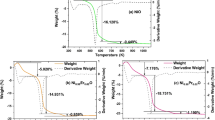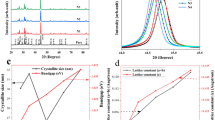Abstract
Nickel doped lead oxide (Pb1-xNixO) nanoparticles with different concentration (x = 0.00, 0.01, 0.05, 0.10, 0.15, 0.20, 0.25, and 0.30) of nickel ion were prepared through a sol-gel route of synthesis. X-ray diffraction and transmission electron microscopic techniques confirmed the nanocrystallinity of the samples as the average sizes of the crystallites were found within 9–25 nm. The substitution of Pb2 + with Ni2 + caused of decrease of particle size with the increase of Ni2 + concentration. The EDS analysis confirmed the present of nickel ion in the Ni doped PbO nanocrystallites. The FT-IR spectra of the samples recorded to look for the distinct absorbance bands highlighting the atomic vibrations. The optical band gap energies (Eg) increased when the nanocrystallites became smaller in size. There is possibility of increase in vacancy defect concentration due to Ni doping that may also be the cause of Eg enhancement. The latter aspect is attributable to the onset of quantum confinement effects as seen in the case of a few other metal oxide nanoparticles. Positron annihilation studies focused on the vacancy type defects which were present in abundance in the samples and played crucial roles in modulating their properties. The concentrations of defects were significantly larger in the samples of lower crystallite sizes. The results supported the feasibility of tailoring the properties of lead oxide nanocrystallites for technological applications apart from the physical insight into the structural build-up when crystallites were formed with finite number of atoms and their distribution governed by site stabilization energy considerations.

The figure shows the normalized optical absorption (OA) spectra of selected (undoped, 1%, 10%, and 25% Ni doped PbO) samples which reflects the lower optical absorbance at higher wavelength region. Also, above 450 nm wavelength there is gradual drop of optical absorbance with the increase in doping concentration. Further, the OA intensity rises slowly for undoped while rapidly for Ni doped samples with the decrease in wavelength at lower wavelength region. The obtained Eg values are 1.78, 1.86, 2.06, and 2.62 eV for undoped, 1% Ni doped, 10% Ni doped and 25% Ni doped PbO, respectively. Clearly, the Eg has gradual increasing values with the increase in Ni doping level. Such enhancement in Eg is quite common with size reduction of NPs due to quantum confinement effect. Decrease in size of NPs has confirmed with increasing Ni doping concentration through XRD analyses. This kind of blue shift in optical band gap values can also be explained by the change in defect states or defect concentrations within the NPs due to the change in doping level. The concentration of vacancy-like defects and defect clusters at the surface of the grain can play an important role in increasing the optical band gap values with the increase in dopant concentration.
Highlights
-
PbO nanoparticles have been prepared with different amount of Nickel doping.
-
XRD, EDS, and UV–Vis Spectroscopy confirmed substitution of Pb2+ ions with Ni2+ and reduction in particle size with doping.
-
Vacancy defects and defect clusters affected band gap of nanoparticles.
-
The results supported the feasibility of tailoring the properties of lead oxide nanocrystallites for technological applications.









Similar content being viewed by others
References
Umar A, Rahman MM, Kim SH, Hahn YB (2008) Zinc oxide nanonail based chemical sensor for hydrazine detection. Chem Commun 2:166 –168
Rahman MM, Jamal A, Khan SB, Faisal M (2011) Highly sensitive ethanol chemical sensor based on Ni-doped SnO2 nanostructure materials. Biosens Bioelectron 28:127–134
Das A, Mandal AC, Roy S, Nambisan PMG (2018) Internal defect structure of calcium doped magnesium oxide nanoparticles studied by positron annihilation spectroscopy. AIP Adv 8:095013
Das A, Mandal AC, Roy S, Nambisan PMG (2016) Mn-doping in NiO nanoparticles: defects-modifications and associated effects investigated through positron annihilation spectroscopy. J Nanosci Nanotech 16:4153–4163
Trinquie G, Hoffmann R (1984) Lead oxide electronic structure and bonding. J Phys Chem 88:6696
Salavati-Niasari M, Mohandes F, Davar F (2009) Preparation of PbO nanocrystals via decomposition of lead oxalate. Polyhedron 28:2263–2267
Pasha SK, Chidambaram K, Kennedy LJ, Vijaya JJ (2010) Lead oxide- PbO humidity sensor. Sensors and Trasducers. Journal 122:113–119
Araujo VD, Andreeta MRB, Maia LJQ, Nascimento RM, Motta FV, Bomio MRD, Paskocimas CA, Bernardi MIB (2015) Microstructural, structural and optical properties of nanoparticles of PbO-CrO3 pigment synthesized by a soft route. Ceramica 61:118–125
Mythili N, Arulmozhi K (2014) Characterization studies on the chemically synthesized α and β phase PbO nanoparticles. Int J Scien Eng Res 5:412–416
Yousefi R, Sheini FJ, Saaedi A, Cheraghizade M(2015) Growth and characterization of PbO nanorods grown using facile oxidation of lead sheet Sains Malaysiana 44:291–294
Pasha SK, Chidambaram K, Vijayan N, Madhuri W (2012) Structural and electrical properties of nano structure lead oxide. Optoelect Adv Mater Rapid Comm 6:110–116
Droessler LM, Assender HE, Watt AAR (2012) Thermally deposited lead oxides for thin film photovoltaics. Mater Lett 71:51–53
Poll CG, Payne DJ (2015) Electrochemical synthesis of PbO2, Pb3O4 and PbO films on a transparent conducting substrate. Electrochim Acta 156:283–288
Nwodo MO, Ezugwu SC, Ezema FI, Osuji RU, Asogwa PU (2011) Effect of thermal annealing on the optical and structural, properties of pbo thin film. J Opto. Biomed Mater 3:95–100
Chen X, Chen S, Clequin PM, Shoulders WT, Gaume R (2015) Combustion synthesis of lead oxide nanopowders for the preparation of PMN–PT transparent ceramics. Ceram Int 41:755–760
Rajabi A, Aieneravaie M, Dorosti V, Sadrnezhaad SK (2014) Development and biomedical application of nanocomposites: in situ fabrication of ZnO–PbO nanocomposite through microwave method. Mater Tech 29:227–231
Radhakrishnan S, Kamalasanam MN, Mahendru PC (1983) Sensitization of photoconductivity in tetragonal lead monoxide. J Mater Sci 18:1912–1916
Algar M, Theivasanthi T, Raja AK (2012) Chemical synthesis of nano-sized particles of lead oxide and their characterization studies. J Appl Sci 12:398–401
Zhou L, Li X, Yao Z, Chen Z, Hong M, Zhu R, Liang Y, Zhao J (2016) Transition-metal doped ceria microspheres with nanoporous structures for CO oxidation. Sci Rep. 6:23900
Mhlongo GH, Shingange K, Tshabalala ZP, Dhonge BP, Mahmoud FA, Mwakikunga BW, Motaung DE (2016) Room temperature ferromagnetism and gas sensing in ZnO nanostructures: influence of intrinsic defects and Mn, Co, Cu doping. Appl Surf Sci 390:804–815
Kharroubi B, Baghdad R, Abdiche A, Bousmaha M, Bousquet M, Zeinert A, Marssi ME, Zellama K, Hamzaoui S (2012) Mn doping effect on the structural properties of ZnO-nanostructured films deposited by the ultrasonic spray pyrolysis method. Phys Scr 86:015805
Akyuz I, Kose S, Atay S, Bilgin V (2006) The optical, structural and morphological properties of ultrasonically sprayed ZnO:Mn films. Semicond Sci Technol 21:1620–1626
Mirzajani V, Farhadi K, Pourmortazavi SM (2018) Catalytic effect of lead oxide nano- and microparticles on thermal decomposition kinetics of energetic compositions containing TEGDN/NC/DAG. J Ther Analy Calor 131:937–948
Wang J, Shen M, Wang J, Yang M, Wang W, Ma J, Jia L (2010) Effects of Ni-doping of ceria-based materials on their micro-structures and dynamic oxygen storage and release behaviors. Catal Lett 140:38
Mahmoudabad MK, Kashani-Motlagh MM (2011) Synthesis and characterization of PbO nanostructure and NiO doped with PbO through combustion of citrate/nitrate gel. Int J Physi Sci 6:5720–5725
Borhade AV, Tope DR, Uphade BK (2012) An efficient photocatalytic degradation of methyl blue dye by using synthesised PbO nanoparticles. E-J Chem 9:705–715
West RN (1973) Positron studies of condensed matter. Adv Phys 22:263–383
Siegel RW (1980) Positron annihilation spectroscopy. Ann Rev Mater Sci 10:393–425
Guan X, Zhou H, Wang Y, Zhang J (2008) Preparation and properties of Gd3+ and Y3+ co-doped ceria- based electrolytes for intermediate temperature solid oxide fuel cells. J Alloy Comound 464:310–316
Pramanik S, Ghosh T, Ghosh M, De SC, Kuiri PK (2018) Quenching of blue–green luminescence of ZnO nanoparticles obtained by solution route with different precursor concentration. J Nanoelectron Optoelectron 13:428–433
Pramanik S, Ghosh T, Ghosh M, De SC, Kuiri PK (2017) Synthesis and time dependent growth of ZnO nanoparticles using solution route, and the defect-free luminescence. Adv Sci. Eng Med 9:414–419
Arulmozhi KT, Mythilli N (2013) Studies on the chemical synthesis and characterization of lead oxide nanoparticles with different organic capping agents. AIP Adv 3:122122
Pramanik S, Mondal S, Mandal AC, Mukherjee S, Das S, Ghosh T, Nath R, Ghosh M, Kuiri PK (2020) Role of oxygen vacancies on the green photoluminescence of microwave-assisted grown ZnO nanorods. J Alloy Compd 849:156684
Lee DH, Condrate RA (1999) FTIR spectral characterization of thin film coatings of oleic acid on glasses: I. coatings on glasses from ethyl alcohol. J Mater Sci 34:139–146
Ali SI, Das A, Agrawal A, Mukherjee S, Ahmed M, Nambissan PMG, Mandal S, Mandal AC (2021) Characterization, spectroscopic investigation of defects by positron annihilation, and possible application of synthesized PbO nanoparticles. Chin Phys B 30:026103
Mukherjee S, Pramanik S, Das S, Chakraborty S, Nath R, Kuiri PK (2020) Structural, optical, and electrical properties of Zn1-xAlxO nanoparticles near the Al solubility limit. J Alloy Compd 814:152015
Kuo SY, Chen WC, Lai FI, Cheng CP, Kuo HC, Wang SC, Hsieh WF (2006) Effects of doping concentration and annealing temperature on properties of highly-oriented Al-doped ZnO films. J Cryst Growth 287:78–84
Kar S, Biswas S, Chaudhuri S, Nambissan PMG (2005) Finite-size effects on band structure of CdS nanocrystallites studied by positron annihilation. Phys Rev B 72:075338
Das S, Ghosal T, Nambissan PMG (2009) Positron annihilation studies of NiO nanoparticles prepared through two different chemical routes. Phys Status Solidi C 6:2569–2571
Das A, Mandal AC, Roy S, Prashanth P, Ahamed SI, Kar S, Prasad MS, Nambissan PMG (2016) Synthesis and characterization of magnesium oxide nanocrystallites and probing the vacancy-type defects through positron annihilation studies. Phys E 83:389–397
Das A, Mandal AC, Roy S, Nambissan PMG (2015) Positron annihilation studies of defects and fine size effects in nanocrystalline nickel oxide. J Exp Nanosci 10:622–639
Kirkegaard P, Olsen JV, Eldrup MM, Pedersen NJ (2009) PALSfit.A computer program for analysing positron lifetime spectra. Riso1652:2-45
Vehanen A, Hautojarvi P, Johansson J, Yli-Kauppila J, Moser P (1982) Vacancies and carbon impurities in α- iron: electron irradiation. Phys Rev B 25:762
Campillo Robles JM, Ogando E, Plazaola F (2007) Positron lifetime calculation for the elements of the periodic table. J Phys: Condens Matter 19:176222
Tuomisto F, Ranki V, Saarinen K, Look DC (2003) Evidence of the Zn vacancy acting as the dominant acceptor in n-type ZnO. Phys Rev Lett 91:205502
Alaei S, Razzazi V (2017) First-principles calculations of structural and thermodynamic properties of β-PbO. Chin Phys B 26:116501
Karami H, Karimi MA, Haghdar S, Sadeghi A, Mir-Ghasemi R, Mahdi-Khani S (2008) Synthesis of lead oxide nanoparticles by Sonochemical method and its application as cathode and anode of lead-acid batteries. Mater Chem Phys 108:337–344
Acknowledgements
The authors are grateful for partial financial support from the University Grants Commission (UGC), New Delhi, India for departmental CAS scheme (No. F. 530/5/CAS/2011(SAP-I)) and from Department of Science and Technology (DST), Govt. of India under FIST (Fund for Improvement in Science & Technology) program (Grant No. SR/FST/PS-II-001/2011). Sk Irsad Ali gratefully acknowledges The University of Burdwan for granting the state-funded fellowship. Also likes to thanks Subhamay Pramanik, Department of Physics, Sidho-Kanho-Birsha University, Purulia, 723104, West Bengal, India for his help to write this article. The authors wish to thank Dr Goutam Das of National Metallurgical Laboratory, Jamshedpur, India for providing the facilities for HRTEM images. The authors also acknowledge Prof P. Mitra, Department of Physics, University of Burdwan for providing instrumental facilities for the synthesis of the samples.
Author information
Authors and Affiliations
Corresponding author
Ethics declarations
Conflict of interest
The authors declare no competing interest.
Additional information
Publisher’s note Springer Nature remains neutral with regard to jurisdictional claims in published maps and institutional affiliations.
Rights and permissions
About this article
Cite this article
Ali, S.I., Das, A., Dutta, D. et al. Investigation of energy band gap and its correlation with vacancy defects in Pb1-xNixO nanoparticles synthesized through sol-gel method. J Sol-Gel Sci Technol 100, 89–100 (2021). https://doi.org/10.1007/s10971-021-05616-9
Received:
Accepted:
Published:
Issue Date:
DOI: https://doi.org/10.1007/s10971-021-05616-9




